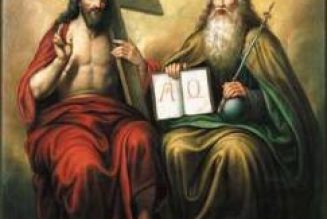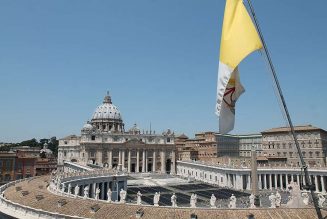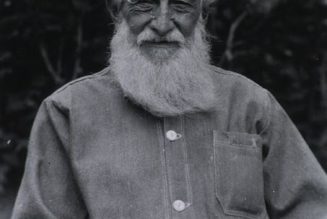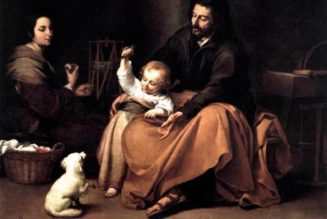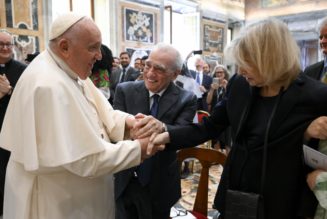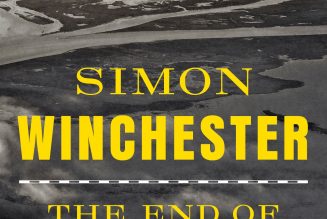Servant of God Brother Columba O’Neill, CSC. University of Notre Dame/Facebook screengrab
With the acceptance and approval of Most Rev. Kevin C. Rhoades, bishop of Fort Wayne-South Bend, Indiana, a new American canonization cause was formally opened in the summer of 2022. The cause of Servant of God Brother Columba O’Neill, CSC, who lived in the diocese for many years at the University of Notre Dame, is being petitioned by the Congregation of Holy Cross, the religious community that operates the university and to which O’Neill belonged as a consecrated religious brother.

A portrait of the founder of the Congregation of Holy Cross, Father Basile-Antoine Marie Moreau, is seen at his beatification ceremony in Le Mans, France, in 2007. (CNS photo/Steven Scardina)
Holy Cross has a handful of active canonization causes for members of the congregation, including its founder, Blessed Basil Moreau, and Venerable Father Patrick Peyton, known as “The Rosary Priest.” And the renown of O’Neill — a simple cobbler who helped bring about miracles in the lives of many through his advocacy of devotion to the Sacred Heart of Jesus and the Immaculate Heart of Mary — is akin to another famous brother of Holy Cross, St. André Bessette, the humble porter and wonderworker of Montreal who built up an army of devotees to St. Joseph across North America.
Early setbacks
A native of Mackeysburg, Pennsylvania, John O’Neill — his name before religious profession — was born on Nov. 5, 1848, as the fifth of six children. O’Neill recalled his father to be “as strict as the blazes,” saying he regularly resorted to physical punishment for his children’s slightest wrongs. Despite concerns at birth that a foot deformity might have meant his quick demise, O’Neill lived 75 years, a feat due in large part to the loving and tender care of the mother who helped her son work to overcome the disability that affected his walking.
Despite this disability, which would make the work more difficult and burdensome, O’Neill grew up under the expectation he would join his father and brothers at work in the nearby coal mine. Both his disability and poor health made this work impossible, though, and O’Neill put himself under the apprenticeship of the village cobbler and took up shoemaking and repair. Having to admit his inability to take up the family trade was a source of pain and character-building humility.
During the 1860s, as the United States was engulfed in civil war, O’Neill’s disability and weakened state prohibited his participation in the Union Army. He instead supported the Union’s efforts by helping produce soldiers’ shoes. At this time, although only in his mid-teens, O’Neill first began to sense a call to religious life. Unsure of how he might best be of service to God, O’Neill set out on a journey West, hoping to discern God’s will for him.
Finding his calling
Believing the Blessed Mother guided his steps, O’Neill eventually made his way to Denver, where he took up work as a cobbler, a position for which there was high demand. At this time, O’Neill developed and nurtured his prayer life through daily Mass, which was a rarity among ordinary laity at the time, and regular prayer in the church before the Blessed Sacrament.
Continuing his journey, O’Neill left Colorado for California, where he spent three years in the early 1870s. He traveled only on foot, earning money by making stops at regular intervals to make and fix shoes. After arriving in the Golden State, O’Neill tried to enter a religious congregation but was rejected on account of his disability.
Refusing to give up on God’s call, O’Neill became intrigued by another itinerant cobbler’s reference to the Congregation of Holy Cross. They were, he was told, hardworking brothers who helped develop others’ skills in various important trades of the time, such as blacksmithing, carpentry and shoemaking. So O’Neill set out for Indiana, intent on visiting the community in which he would eventually find a home. In 1874, he entered the order at the University of Notre Dame, the American provincial headquarters for the Congregation of Holy Cross.
In honor of the great Irish missionary St. Columba, O’Neill took the religious name Columba when he entered the novitiate. He made first vows two years later. In addition to poverty, chastity and obedience, Brother Columba also took Holy Cross’ fourth vow to be prepared and willing to take up any assignment throughout the world as instructed by the superior general.
Instead of India or Molokai — where O’Neill volunteered to go to assist St. Damien’s ministry to lepers — he was sent first to an orphanage in Lafayette, Indiana. It was there that his reputation for great piety and devotion — not to mention for the miraculous — became known. When some of the boys in the orphanage came down with the flu that winter, he brought about cures by blessing them with holy water from the grotto of the famous Marian apparition site at Lourdes, France. He took no credit for the cures but gave thanks to the Sacred Heart of Jesus and the Immaculate Heart of Mary for bringing them about. In 1885, O’Neill returned to Notre Dame, where he operated the college campus shoe shop, a task to which he remained dedicated until his death 38 years later.
A wonderworker

Campus of Notre Dame University in South Bend, Indiana. Shutterstock
O’Neill’s time at Notre Dame was spent in humility and simplicity. Rarely did he leave the school’s campus, preferring to spend his time in quiet prayer and keep the feet of Notre Dame’s students well tended to. He carried on a wide healing ministry through the production and distribution of small paper devotional badges with images of the Sacred Heart of Jesus and Immaculate Heart of Mary. Throughout the student body to which he ministered, O’Neill gained a reputation as a wonderworker for thousands who wrote to him about their physical sufferings and their need for cures. Favors poured in, and he continued to credit them to the merciful Sacred Heart of Jesus and the consoling Immaculate Heart of Mary.
More than 10,000 letters written to O’Neill remain in the Midwest provincial archives of the Brothers of Holy Cross. More than 1,000 identify the help of his prayers in healings and favors. Born of O’Neill’s own virtue, intense prayer and simple sanctity, his ordinary, childlike faith and devotion brought Christ’s love and mercy to those who needed it most. His appeal reached a large cross-section of Catholics who reverenced his mortal remains, after his Nov. 23, 1923, death, as those having belonged to a saint. His grave on Notre Dame’s campus has been a place of pilgrimage for countless members of the faithful who still seek the assistance of his prayers.
O’Neill’s reputation for holiness and heroic virtue has endured throughout the nearly 100 years since his death. His cause now advances with the ordinary tasks of proving his virtue and sanctity.
Michael R. Heinlein is editor of OSV’s Simply Catholic. He writes from Indiana.
Join Our Telegram Group : Salvation & Prosperity



